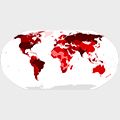Risultati di ricerca
Coronavirus disease (COVID-19) is an infectious disease caused by the SARS-CoV-2 virus. Most people infected with the virus will experience mild to moderate respiratory illness and recover without requiring special treatment. However, some will become seriously ill and require medical attention.
Coronavirus disease (COVID-19) WHO lists additional mpox diagnostic tests for emergency use. WHO and partners activate Global Health Emergency Corps for the first time in response to mpox outbreak. Tuberculosis resurges as top infectious disease killer.
9 ago 2023 · COVID-19 is the disease caused by the SARS-CoV-2 coronavirus. It usually spreads between people in close contact. COVID-19 vaccines provide strong protection against severe illness and death. Although a person can still get COVID-19 after vaccination, they are more likely to have mild or no symptoms. Anyone can get sick with COVID-19 and become ...
COVID-19 vaccination – Local Government Area (LGA) – 13 September 2024. These reports list the percentage of people who have been vaccinated against COVID-19 by local government area (LGA). Find information on COVID-19, how to protect yourself and those around you, and the current situation in Australia.
28 mar 2023 · nausea, vomiting, abdominal pain/ belly ache, or diarrhoea. Symptoms of severe COVID‐19 disease which need immediate medical attention include: difficulty in breathing, especially at rest, or unable to speak in sentences. skin being cold or clammy, or turning pale or a bluish colour. If possible, call your health care provider, hotline or ...
Links and resources. The coronavirus disease 2019 (COVID-19) pandemic is a global outbreak of coronavirus – an infectious disease caused by the severe acute respiratory syndrome coronavirus 2 (SARS-CoV-2). Cases of novel coronavirus (nCoV) were first detected in China in December 2019, with the virus spreading rapidly to other countries ...
17 giu 2024 · Coronavirus disease (COVID-19) Epidemiological Updates and Monthly Operational Updates. The Epidemiological Update provides an overview of the global, regional and country-level COVID-19 cases and deaths, highlighting key data and trends; as well as other pertinent epidemiological information concerning the COVID-19 pandemic.
The “Three C’s” are a useful way to think about this. They describe settings where transmission of the COVID-19 virus spreads more easily: Close-contact settings, especially where people have conversations very near each other; Confined and enclosed spaces with poor ventilation. The risk of COVID-19 spreading is especially high in places ...
18 mar 2023 · Cover your mouth and nose with your bent elbow or a tissue when you cough or sneeze. Dispose of the used tissue immediately into a closed bin and wash your hands. Clean and disinfect surfaces frequently, especially those which are regularly touched, such as door handles, faucets and phone screens.
COVID-19 vaccines. Everyone, everywhere, should have access to COVID-19 vaccines. Major progress has been made with the COVID-19 vaccination response, and it is critical to continue the progress, particularly for those most at risk of disease. WHO recommends a simplified single-dose regime for primary immunization for most COVID-19 vaccines ...

